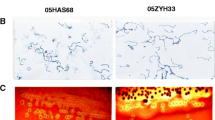Abstract
The trag is a novel infection-related factor identified using in vivo-induced antigen technology (IVIAT) from SS2 expression libraries with swine convalescent sera. PCR-based studies of various S. suis strains collected from different sources revealed that the trag gene was present in all the virulent SS2 strains, but absent in the avirulent T15 strain. PCR and Southern hybridization analyses of a trag-knockout strain created through homologous recombination confirmed the coding sequence of trag replaced by spc R cassette in the ∆trag mutant. Zebrafish was used to identify the role of trag in SS2 virulence. The reduction of virulence in the trag mutant compared to the wild-type in animal model systems, laid the foundation for further studies.

Similar content being viewed by others
References
Chanter N, Jones PW, Alexander TJ (1993) Meningitis in pigs caused by Streptococcus suis: a speculative review. Vet Microbiol 36:39–55
Staats JJ, Feder I, Okwumabua O, Chengappa MM (1997) Streptococcus suis: past and present. Vet Res Commun 21:381–407
Yu H, Jing H, Chen Z, Zheng H, Zhu X et al (2006) Human Streptococcus suis outbreak, Sichuan, China. Emerg Infect Dis 12:914–920
Tang J, Wang C, Feng Y, Yang W, Song H et al (2006) Streptococcal toxic shock syndrome caused by Streptococcus suis serotype 2. PLoS Med 3:e151
Yao H, Chen G, Lu C (1999) The identification of swine streptococcus isolates of Jiangsu province in 1998. J Nanjing Agric Univ 22:67–70
Gu HW, Zhu H, Lu CP (2009) Use of in vivo-induced antigen technology (IVIAT) for the identification of Streptococcus suis type 2 in vivo-induced bacterial protein antigens. BMC Microbiol 9:201–215
Jiang H, Fan HJ, Lu CP (2009) Identification and distribution of putative virulent genes in strains of Streptococcus suis serotype 2. Vet Microbiol 133:309–316
Takamatsu D, Osaki M, Sekizaki T (2001) Construction and characterization of Streptococcus suis–Escherichia coli shuttle cloning vectors. Plasmid 45:101–113
Sambrook J, Fritsch EF, Maniatis T (1989) Molecular cloning: a laboratory manual, 2nd edn. Cold Spring Harbor Laboratory Press, Cold Spring Harbor, New York
Smith HE, Wisselink HJ, Vecht U, Gielkens AL, Smits MA (1995) High-efficiency transformation and gene inactivation in Streptococcus suis type 2. Microbiology 141(Pt 1):181–188
Wu Z, Zhang W, Lu C (2008) Comparative proteome analysis of secreted proteins of Streptococcus suis serotype 9 isolates from diseased and healthy pigs. Microb Pathog 45:159–166
OIE. Available from: http://www.oie.int/eng/info/hebdo/AIS_54.htm
Hamilton MA, Russo RC, Thurston RV (1997) Trimmed Spearman-Karber method for estimating median lethal concentrations in toxicity bioassays. Environ Sci Technol 11:714–719
Charland N, Harel J, Kobisch M, Lacasse S, Gottschalk M (1998) Streptococcus suis serotype 2 mutants deficient in capsular expression. Microbiology 144(Pt 2):325–332
Smith HE, Damman M, van der Velde J, Wagenaar F, Wisselink HJ et al (1999) Identification and characterization of the cps locus of Streptococcus suis serotype 2: the capsule protects against phagocytosis and is an important virulence factor. Infect Immun 67:1750–1756
Cotter PA, DiRita VJ (2000) Bacterial virulence gene regulation: an evolutionary perspective. Annu Rev Microbiol 54:519–565
Smith HE, Vecht U, Wisselink HJ, Stockhofe-Zurwieden N, Biermann Y et al (1996) Mutants of Streptococcus suis types 1 and 2 impaired in expression of muramidase-released protein and extracellular protein induce disease in newborn germfree pigs. Infect Immun 64:4409–4412
Vecht U, Wisselink HJ, Jellema ML, Smith HE (1991) Identification of two proteins associated with virulence of Streptococcus suis type 2. Infect Immun 59:3156–3162
Gort AS, Miller VL (2000) Identification and characterization of Yersinia enterocolitica genes induced during systemic infection. Infect Immun 68:6633–6642
Heithoff DM, Conner CP, Hanna PC, Julio SM, Hentschel U, Mahan MJ (1997) Bacterial infection as assessed by in vivo gene expression. Proc Natl Acad Sci USA 94:934–939
Mahan MJ, Tobias JW, Slauch JM, Hanna PC, Collier RJ, Mekalanos JJ (1995) Antibiotic-based selection for bacterial genes that are specifically induced during infection of a host. Proc Natl Acad Sci USA 92:669–673
Chen C, Tang J, Dong W, Wang C, Feng Y et al (2007) A glimpse of streptococcal toxic shock syndrome from comparative genomics of S. suis 2 Chinese isolates. PLoS One 2:e315
Bourzac KM, Guillemin K (2005) Helicobacter pylori-host cell interactions mediated by type IV secretion. Cell Microbiol 7(7):911–919
van der Sar AM, Appelmelk BJ, Vandenbroucke-Grauls CM, Bitter W (2004) A star with stripes: zebrafish as an infection model. Trends Microbiol 12:451–457
Miller JD, Neely MN (2004) Zebrafish as a model host for streptococcal pathogenesis. Acta Trop 91:53–68
Acknowledgments
This study was supported by grants from the National Basic Research Program of China (2006CB504403), the National Natural Science Foundation of China (No. 30771605), and the Program for New Century Excellent Talents (NCET) in University (No. NCET-08-0794) of China.
Author information
Authors and Affiliations
Corresponding author
Rights and permissions
About this article
Cite this article
Zhang, H., Fan, H. & Lu, C. Identification of a Novel Virulence-Related Gene in Streptococcus suis Type 2 Strains. Curr Microbiol 61, 494–499 (2010). https://doi.org/10.1007/s00284-010-9643-0
Received:
Accepted:
Published:
Issue Date:
DOI: https://doi.org/10.1007/s00284-010-9643-0




